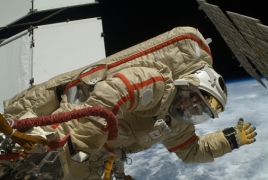
The rigors and challenges of spaceflight are remarkably similar to the physical stress cancer patients experiment during chemotherapy and other treatments, according to researchers.
For that reason, the researchers suggest that the countermeasures program used by astronauts before, during and after spaceflight to maintain their health could be developed and applied for cancer patients to help them recover after treatment, CNN reports.
The details were published in a commentary written by researchers from Memorial Sloan Kettering Cancer Center and NASA on Thursday in the journal Cell. The work was supported by the National Cancer Institute.
"It was surprising when we looked at similarities between astronauts during spaceflight and cancer patients during treatment.
Both have a decrease in muscle mass, and they have bone demineralization and changes in heart function," said Jessica Scott, senior author and an exercise physiology researcher at the Memorial Sloan Kettering Cancer Center's Exercise Oncology Service. "Astronauts may get something called space fog, where they have trouble focusing or get a little forgetful.
That's very similar to what some cancer patients experience, which is called chemo brain."
But astronauts and cancer patients are advised in a completely different way from each other, despite the similar issues they face. The authors of the commentary looked at the countermeasures program created by NASA to see how it might be applied to cancer patients.
For 58 years, NASA has been sending humans into space, with flights ranging from 15 minutes in duration in 1961 to nearly a year on the International Space Station for current astronauts.
The quest for countermeasures to help humans remain stable and healthy in space began early. They didn't know what effect zero gravity might have on the body or specific organs. And they were mainly concerned with cardiac injury, so multiple assessments were used to monitor that activity before, during and after flight, according to the commentary.

